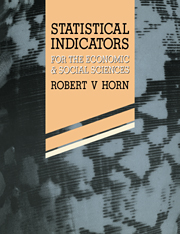Book contents
CHAPTER 1 - FROM STATISTICS TO INDICATORS
Published online by Cambridge University Press: 27 October 2009
Summary
Introduction
This book deals with applications of statistics to the social sciences, including economics and other areas usually styled as ‘social’, such as sociology, social policy and planning. Examples are drawn mainly from those disciplines, but some applications extend to the natural sciences. The discussion does not stretch to the higher reaches of epistemology, semantics and general philosophy; rather it looks more practically at the purpose of indicators and, from there, to their nature and construction.
Sections 1.2 to 1.4 that follow discuss the statistical derivation of indicators, their structure and typology, and their use in scientific analysis. Then Chapter 2 ‘Indicator techniques’ outlines some of the major statistical techniques and characteristics used for indicators. This material is based on the general statistical textbook literature, to which reference should be made for further detail. In Chapters 3 to 5 particular indicator applications in various fields of economics and social analysis are discussed. There are brief descriptions of some of the major subject matter, and references to sources in the bibliography, but the main emphasis is on identification of the processes involved and on appropriate socioeconomic measurement. Finally, Chapter 6 presents a summary of the main features of indicator analysis.
The bibliography covers some classic texts but concentrates otherwise on a selection of fairly recent titles, which themselves list further references, chosen from the very large literature in the various branches of the social sciences.
- Type
- Chapter
- Information
- Statistical IndicatorsFor the Economic and Social Sciences, pp. 1 - 15Publisher: Cambridge University PressPrint publication year: 1993



